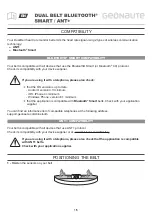
English-39
English
U-12
Remote control (continued)
Carry out as necessary
5) Read
command
The computer sends the command without datacode to the monitor.
After receiving this command, the monitor returns the command with datacode including the current status to the computer.
Example: When the computer asks the power status of the monitor, and the status of the monitor is powered-on.
Command from computer
Command from monitor
Detail of command
30 30 76 50 0D ‘0’‘0’‘v’‘P’[enter]
Ask about the power status of the monitor.
30 30 76 50 31 0D ‘0’‘0’‘v’‘P’‘1’[enter]
Monitor is powered-on.
Structure of the Read-command
ASCII
HEX
Function
Data (Receive)
Function
Data (Receive)
POWER
ON
vP
1
76 50
31
OFF (Sleep)
vP
0
76 50
30
Input
RGB-1 (HDMI)
vI
r1
76 49
72 31
RGB-2 (DVI-D)
vI
r2
76 49
72 32
RGB-3 (D-SUB)
vI
r3
76 49
72 33
RGB-4 (BNC)
vI
r4
76 49
72 34
OPTION*
vI
r5
76 49
72 35
RGB-6 (DISPLAY PORT)
vI
r6
76 49
72 36
Video
vI
v1
76 49
76 31
DVD/HD
vI
v2
76 49
76 32
S-VIDEO
vI
v3
76 49
76 33
Internal
temperature
Around the main
board
Resolution
1˚C
tc1
(ex.) +25
74 63 31
2B 20 32 35
Around the power
supply
Resolution
1˚C
tc2
(ex.) +31
74 63 32
2B 20 33 31
*
OPTION can be used when an optional module is mounted on the option slot.
LAN Remote control
By connecting the monitor and the computer using a network device such as a LAN hub as shown in Section P-7 and making
the network settings using the OSD menu and RS-232C communication control, you can perform remote control using the same
commands as those for RS-232C.
1. Setting
procedure
(1) Set the following network parameters using the OSD menu. (See page 48.)
• DHCP client ON/OFF, IP address, subnet mask and default gateway
(2) Set the IP address described above and the port number (63007 or 3007) using the application program of your computer to
perform the socket communication.
(3) Send the same control command as that for RS-232C via TCP/IP socket communication.
(4) Check the status sent from the monitor. When it is received successfully, the setting is completed.
















































